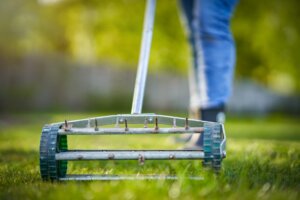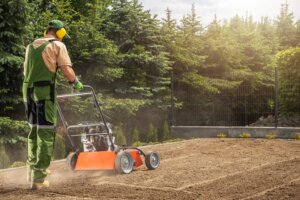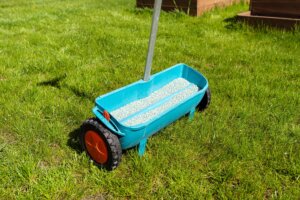A recent EPA report notes that turf grasses cover roughly 50 million acres across the U.S., with 75% of that being residential lawns, making fertilizer runoff a significant contributor to nutrient pollution and water quality issues.
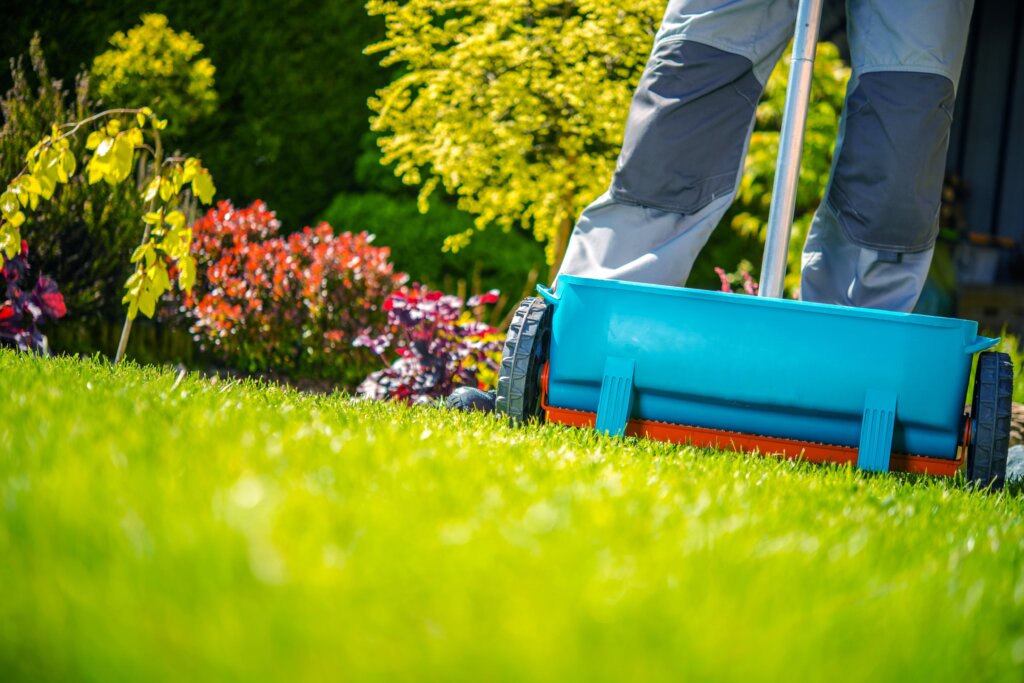
TL;DR: 8 Key Steps At A Glance
- Test Your Soil – Begin with a soil test to identify pH levels and nutrient needs.
- Choose the Right Fertilizer – Select granular, liquid, or organic fertilizer based on your grass type and soil condition.
- Fertilize by Season – Schedule fertilizer applications based on your grass type: feed cool-season grasses in early spring and late fall, and warm-season grasses in late spring through early summer, to maximize nutrient uptake and lawn health.
- Mow and Prepare – Mow to about 3 inches and clear debris before fertilizing.
- Apply Evenly – Use a fertilizer spreader to cover your lawn in straight lines without overlap.
- Water Correctly – Adjust watering based on fertilizer type to help nutrients reach the roots.
- Maintain Regularly – Keep up with mowing, watering, and aeration to sustain healthy growth.
- Control Pests Naturally – A well-fertilized lawn resists weeds and pests more effectively.
Keeping your lawn healthy demands more than just watering and mowing; you need the right nutrients applied at the right time. This professional guide from Terra Lawn Care explains how to fertilize lawn areas in Pennsylvania effectively, covering soil testing, fertilizer types, application methods, and seasonal scheduling to achieve a deeper green and stronger root system.
Step 1: Test Your Soil Before Fertilizing
Before you apply any lawn fertilizer, start with a soil test to determine nutrient levels and pH balance. Pennsylvania soils often vary between acidic and neutral, so testing ensures you provide the essential nutrients your grass type needs, including nitrogen, phosphorus, and potassium.
For homeowners unsure how to interpret results, consider consulting a lawn care professional. You should also see our blog post on How to Apply Lawn Fertilizer to understand the right timing and preparation methods.
Step 2: Choose the Right Lawn Fertilizer
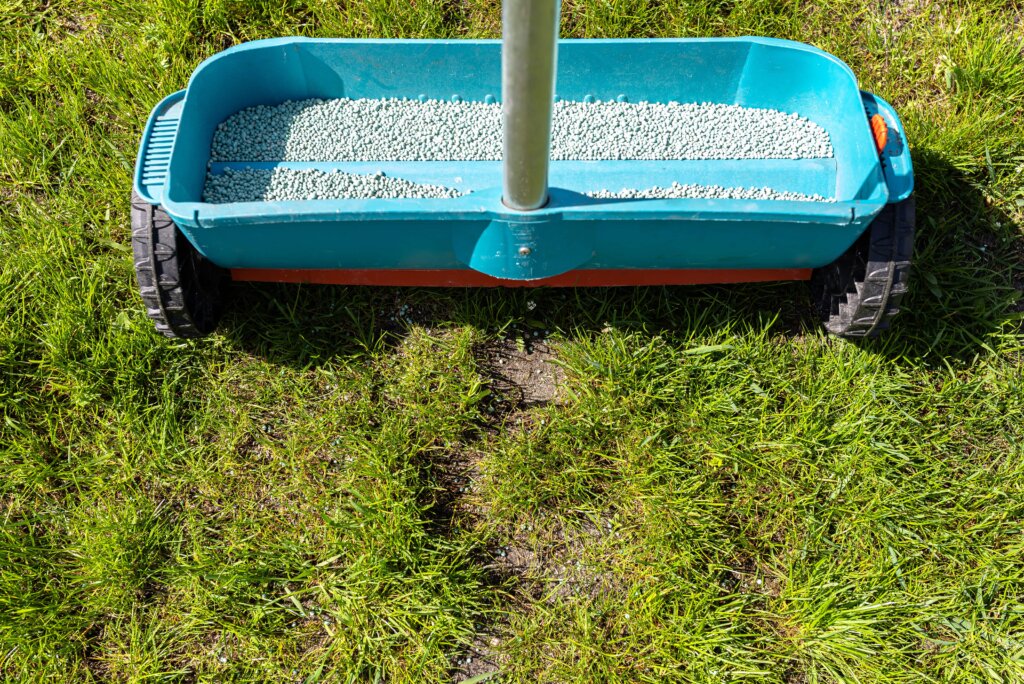
Your lawn’s success depends on selecting the right fertilizer for its needs. There are several types to consider:
Granular Fertilizers
Granular fertilizers are ideal for providing a steady release of nutrients and giving you more control over application rates. They’re especially effective for applying granular fertilizer evenly across large home lawn areas, helping maintain consistent growth and color throughout the season.
Liquid Fertilizers
Liquid fertilizers offer fast absorption and are best when your turf needs an immediate nutrient boost. These are particularly useful during periods of active growth or when you want to correct nutrient deficiencies quickly. Learn the differences by checking out our expert guide about How to Use Fertilizer.
Organic Fertilizers
Organic fertilizers and other natural fertilizers, such as compost, manure, or bone meal, enhance soil structure and boost microbial activity over time. They not only feed your grass but also improve long-term soil health and resilience against drought and disease.
Step 3: Fertilize Your Lawn by Season and Timing
Feeding your lawn at the right time supports steady growth, deeper roots, and year-round resilience. The ideal fertilizer type and nutrient balance depend on both the season and your grass type.
| Season | Best Fertilizer Type | Purpose & Key Benefits |
|---|---|---|
| Early Spring | Use starter fertilizers rich in phosphorus. | Jumpstarts actively growing turf, promotes root system development, and helps establish a lush lawn early. |
| Late Spring to Early Summer | Apply nitrogen-heavy fertilizer with slow-release nutrients. | Encourages dense grass growth, strengthens turfgrass, and prevents broadleaf weeds during the growing season. |
| Mid to Late Summer | Use a potassium-rich formula for warm-season grasses. | Maintains drought and heat tolerance, preventing turf stress during high temperatures. |
| Fall | Feed cool-season grasses with balanced NPK fertilizer. | Reinforces the root system, preparing turf for winter dormancy and supporting early spring growth. |
Applying fertilizers during spring and fall helps prevent broadleaf weeds, supports other plants, and encourages a greener lawn year-round.
Best Time to Fertilize Your Lawn
Timing plays a major role in how well your lawn fertilizer works. The right schedule helps your lawn absorb nutrients efficiently, build stronger roots, and prevent damage caused by heat, weeds, or nutrient runoff.
Cool-Season Grasses
For cool-season grasses, focus on spring application and late fall feeding. Early spring fertilizer boosts recovery after winter dormancy, while a fall dose rich in nitrogen, phosphorus, and potassium strengthens roots before cold weather sets in.
Warm-Season Grasses
These varieties thrive when you fertilize your lawn in late spring through early summer. Use a balanced or organic fertilizer with enough nitrogen to promote lush growth and potash to enhance drought resistance during warmer months.
Avoid Extreme Conditions
Skip fertilizing right before heavy rainfall or during peak heat to prevent damage and nutrient loss. Instead, apply evenly using a calibrated spreader, covering your square footage in straight lines to avoid over-fertilizing sidewalks or nearby plants.
Evenly timed applications like these help your lawn depend less on quick fixes and more on a steady nutrient supply for year-round health and vibrant green color, especially for homeowners across the Tri-State area.
Step 4: Mow and Prepare the Lawn
Before fertilizing, make sure your lawn is freshly mowed and clear of debris. Mowing your lawn before fertilizing allows nutrients to reach the soil instead of sticking to grass clippings or debris, as explained in pre-fertilization mowing practices.
Avoid cutting too short; a height of about 3 inches works best for most home lawn types. Dispose of excess lawn clippings if they’re too thick, but a light layer can return valuable nutrients to your turf.
Step 5: Apply Fertilizer Evenly and at a Steady Pace

Even application prevents too much fertilizer from burning your turf or causing uneven growth. Use a fertilizer spreader or lawn spreader to maintain straight lines and a steady pace while covering the entire lawn.
Read our blog on Fertilizer Application: Your Ultimate Guide to a Lush, Healthy Lawn for accurate application rates and timing. After spreading, blow fertilizer granules off driveways, sidewalks, and other hard surfaces to prevent runoff into storm drains and protect the environment from pollution.
Step 6: Water Properly After Fertilizing
Watering helps nutrients reach the root system, where plant growth begins; however, the timing matters. If you’re wondering whether to water right after fertilizing, it depends on the type of fertilizer; some need immediate watering, while others work best when left to absorb first.
In general, a slow-release fertilizer benefits from light watering, while liquid feed products may be best applied before rainfall. Proper watering prevents runoff, supports turf recovery, and ensures nutrients penetrate the soil effectively.
Step 7: Maintain Your Lawn After Fertilizing
Keep your fertilized lawn thriving with consistent maintenance. Water regularly, mow at the proper height, and aerate yearly to enhance oxygen flow to roots. Store your fertilizers in a dry place and avoid overusing weed killers or chemicals that may harm beneficial microbes.
For alternative methods of fertilizer application, you can explore specialized techniques suited for different soil and turf conditions.
Step 8: Pest Control: The Power of a Well-Fertilized Lawn
A well-fertilized lawn not only looks great but also helps keep pests away. Strong, healthy grass is less prone to weeds, insects, and disease because it offers fewer hiding spots and food sources. At Terra Lawn Care, our lawn fertilization services strengthen your turf while supporting natural pest resistance for a healthier, greener yard.
Keep Your Home Lawn Thriving Year-Round
Fertilizing your home lawn doesn’t have to be complicated. With the right fertilizer type, proper timing, and expert application techniques, you can maintain a lush, healthy yard that thrives through every Pennsylvania season. Whether you prefer organic fertilizer, granular, or liquid formulas, consistency remains the key to deep roots and lasting green.
For professional care and tailored solutions, contact Terra Lawn Care Specialists today to keep your lawn vibrant and well-nourished year-round.
Frequently Asked Questions About How to Fertilize Lawn
To apply fertilizer effectively, start by using a spreader to ensure even coverage across your yard. Walk at a steady pace in straight lines to avoid over-fertilizing certain areas.
Always clear away excess fertilizer from sidewalks or driveways to prevent runoff into drains. Remember, even distribution helps provide nutrients evenly to your grass for consistent color and healthy growth.
The best time to apply fertilizer depends on your grass type and season. For cool-season grasses, early spring and fall are ideal since your lawn is actively growing.
For warm-season grasses, late spring through summer is best. Fertilizing at these times ensures your lawn absorbs nutrients efficiently and builds a strong root system before temperature extremes.
It depends on the type of lawn fertilizer used. Granular fertilizers usually need watering afterward to help nutrients reach the soil, while liquid fertilizers often work best when applied to slightly moist grass. Proper water management ensures your fertilizer penetrates deep into the soil and doesn’t sit on the surface where it could burn the grass.
Ideally, fertilize slightly damp grass—not soaking wet or completely dry. Lightly moist conditions help the fertilizer stick to blades without clumping. This allows the soil to better absorb micronutrients and other essential elements your grass needs to feed and grow. Avoid fertilizing right before heavy rain to prevent weeds from spreading or nutrients from washing away.

